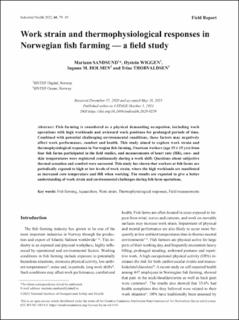| dc.contributor.author | Sandsund, Mariann | |
| dc.contributor.author | Wiggen, Øystein | |
| dc.contributor.author | Holmen, Ingunn Marie | |
| dc.contributor.author | Thorvaldsen, Trine | |
| dc.date.accessioned | 2022-08-26T12:38:44Z | |
| dc.date.available | 2022-08-26T12:38:44Z | |
| dc.date.created | 2022-01-05T14:39:20Z | |
| dc.date.issued | 2021 | |
| dc.identifier.citation | Industrial Health. 2022, 60 (1), 79-85. | en_US |
| dc.identifier.issn | 0019-8366 | |
| dc.identifier.uri | https://hdl.handle.net/11250/3013807 | |
| dc.description.abstract | Fish farming is considered as a physical demanding occupation, including work operations with high workloads and awkward work positions for prolonged periods of time. Combined with potential challenging environmental conditions, these factors may negatively affect work performance, comfort and health. This study aimed to explore work strain and thermophysiological responses in Norwegian fish farming. Fourteen workers (age 35 ± 15 yrs) from four fish farms participated in the field studies, and measurements of heart rate (HR), core- and skin temperatures were registered continuously during a work shift. Questions about subjective thermal sensation and comfort were answered. This study has shown that workers at fish farms are periodically exposed to high or low levels of work strain, where the high workloads are manifested as increased core temperature and HR when working. The results are expected to give a better understanding of work strain and environmental challenges during fish farm operations. | en_US |
| dc.language.iso | eng | en_US |
| dc.rights | Attribution-NonCommercial-NoDerivatives 4.0 Internasjonal | * |
| dc.rights.uri | http://creativecommons.org/licenses/by-nc-nd/4.0/deed.no | * |
| dc.subject | Fish farming | en_US |
| dc.subject | Aquaculture | en_US |
| dc.subject | Work strain | en_US |
| dc.subject | Thermophysiological responses | en_US |
| dc.subject | Field measurements | en_US |
| dc.title | Work strain and thermophysiological responses in Norwegian fish farming — a field study | en_US |
| dc.type | Peer reviewed | en_US |
| dc.type | Journal article | en_US |
| dc.description.version | publishedVersion | en_US |
| dc.rights.holder | ©️ 2022 National Institute of Occupational Safety and Health | en_US |
| dc.source.pagenumber | 79-85 | en_US |
| dc.source.volume | 60 | en_US |
| dc.source.journal | Industrial Health | en_US |
| dc.source.issue | 1 | en_US |
| dc.identifier.doi | 10.2486/indhealth.2020-0259 | |
| dc.identifier.cristin | 1975277 | |
| dc.relation.project | Norges forskningsråd: 254899 | en_US |
| cristin.ispublished | true | |
| cristin.fulltext | postprint | |
| cristin.qualitycode | 1 | |

